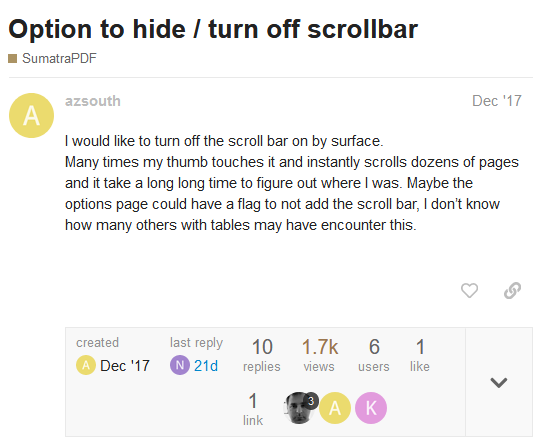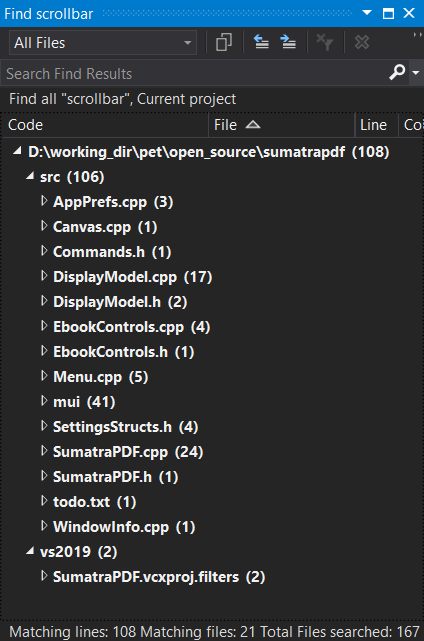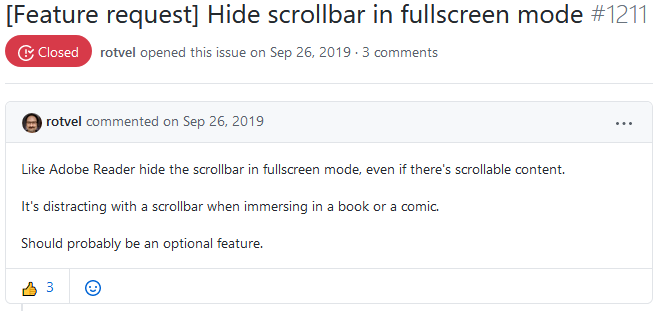I added a feature that was "impossible" for three years
Adding the option to hide scrollbar to SumatraPDF
 Source: Paul Kapischka (https://unsplash.com/photos/N5hZ_3_Wf-s)
Source: Paul Kapischka (https://unsplash.com/photos/N5hZ_3_Wf-s)
Facing a seemingly impossible task? Fret not, read on for a story of how I dealt with one (and perhaps learn something about C++ and Win32 API GUI programming along the way)
TL;DR
I wanted to add a feature to a piece of open-source tool I've been using for quite some time, but discovered that the feature was requested many years ago and was deemed to complicated.
I went ahead anyway, with a language I haven't used in over 10 years, and worked through numerous problems to get the feature implemented.
Background
I'm a huge proponent of not wasting screen real estate on UI crufts like title bars, tab bars, scrollbars etc.
Naturally, since I use a Windows machine, my PDF reader of choice is SumatraPDF, with menu bar and tool bars that can be hidden, and even a full screen mode that hides everything else… everything else besides the scrollbar.
And thus began my journey of trying to remove the scrollbar.
Initial Googl-ing
I'm usually not the first person to come up with a good feature request, so I turned to the Internet to find like-minded people before me.
-
Unfortunately for me, the feature requests I did find, but solutions I did not: the feature was deemed too troublesome.
-
https://forum.sumatrapdfreader.org/t/option-to-hide-turn-off-scrollbar/705

(If you are reading this is dark mode, apologies for the blinding screenshots above.)
Thankfully, I had some time on my hand, and the lack of ability to hide the scrollbars is the last remaining feature that is preventing SumatraPDF from being the perfect PDF reader for me, so I decided to go ahead anyway.
Setting Up and Finding Where to Start
At first, I had absolutely no idea at all where to begin, so the first thing I did was to visit the project GitHub page (over here).
The author had a simple but excellent readme.md explaining how to compile and
the application. And despite it being more than 10 years since I first touched
C++, I was able to compile the application with no issue. Kudos to excellent
documentation by the author!
Naive Approach - Passing false to ShowScrollBar()
Even with the code in hand (or on my hard disk to be accurate), I had no idea where to begin.
But what I do know is that I would like to remove the scrollbars in fullscreen mode, so I searched the whole project for the word "scrollbar", roughly along the following lines:
-
Press
<Ctrl>+<Shift>+Fto bring up theFind and Replacedialog box, enter the words "scrollbar", unselect the optionsMatch case,Match whole wordandUse regular expressions, and clickedFind All: -
The search matched 108 lines in 21 files—definitely a manageable amount to go through:

(I initially seacrh for the word "scroll", but that had way too many hits)
The first file to caught my eye is the aptly named SumatraPDF.cpp, since
that's the name of the application itself. And from there I found the function
UpdateScrollbar()—Jackpot!! (or so I thought, once again).
-
In the
UpdateScrollbar()function itself, there were calls toShowScrollBar(...):ShowScrollBar(win->hwndCanvas, SB_HORZ, viewPort.dx < canvas.dx); -
A Google search on the
ShowScrollBar()function led me to the Microsoft documentation which explained that the third argument is aBOOLindicating whether to show or hide the scrollbars. -
I was so excited, and immediately try setting the value to
falseto check whether it works—surprise, it didn't.
I guess I have no choice but to read the manual. As the saying goes: "Remember, a few hours of trial and error can save you several minutes of looking at the README.". So I finally Google "Win32 API C++ programming", and landed on Get Started with Win32 and C++.
Basic Working Approach - Intercepting the WM_NCPAINT Message
After reading through the official documentation, I understood that UI updates are the result of processing a series of messages.
-
My Gut Feel™ tells me that the reason my previous approach (of passing
falseas the last argument to theShowScrollBars()function) didn't work possibly because somewhere along the processing chain, a subsequent message on the queue superceded that particular function call. -
So how do I deal with this?
The most direct way that came to my mind was this—to intercept the final
message just before the scrollbars will (or will not) be drawn, and call
ShowScrollBars() again.
-
After digging through the official documentation, I found that the message to intercept is
WM_NCPaint, which is sent when the "non-client" areas of the UI is to be painted. (Non-client means areas like the title bars, borders, and—of course—scrollbars.) -
To intercept the message, this is what I used (I hardcoded the third argument to
FALSEto test that it works):case WM_NCPAINT: ShowScrollBar(win->hwndCanvas, SB_BOTH, FALSE); return TRUE; -
But how do I know where to insert this? Simple, I know from the documentation that all application must handle
WM_PAINTto update the "client" UI (i.e., the main content area besides the title bar, borders, etc.). So I did a global search and found the functionWndProcCanvasFixedPageUi(), and inserted my code fragment above, and—viola!—no scrollbars.
Let me repeat: ~ No Scrollbars ~
To Be Continued
This post has gone rambling on for quite a while. But is gist, using just the above knowledge, it wasn't too difficult to implement a setting that will enable turning scrollbars off.
-
However, every time the setting changed, the application must be reload, and this just won't do it for me—one of the primary reason why SumatraPDF is such a delight is that it responds to settings changes and file changes immediately.
In a future post, I'll share more about how I was able to react to changes in settings immediately, and rounding off with submitting my pull request and implementing a context menu as requested by the author.
Lessons Learnt (so far)
When working with a heavily customized piece of software like SumatraPDF, expect a lot—and I mean A LOT—of edge cases, each and every one meant to delight end-user (with or without them knowing). For example, if you highlighted a chunk of text in SumatraPDF and you change the zoom setting, the software will try is best to keep the highlighted text visible. Now, go try this in something like Firefox and see what happens (hint: Firefox doesn't really care that you have a chunk of text highlighted.)
Read the official document for Win32 API at Get Started with Win32 and C++, to save yourself hours of headaches.
The pull request is over here if you are interested.
